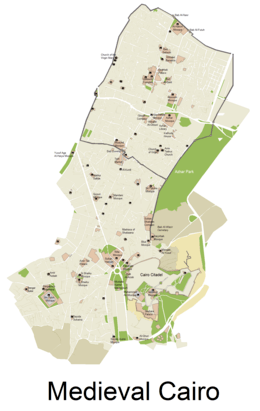Cairo Citadel
| Cairo Citadel قلعة صلاح الدين الأيوبي | |
|---|---|
| Islamic Cairo, Cairo, Egypt | |
.jpg) Cairo Citadel and Mosque of Muhammad Ali, seen from Salah El-Deen Street | |
| Type |
Ayyubid citadel Ottoman citadel |
| Site information | |
| Condition | Intact |
| Site history | |
| Built |
|
| Built by |
|
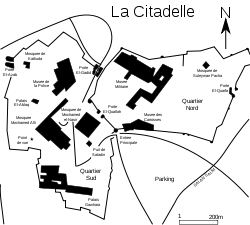
The Saladin Citadel of Cairo (Arabic: قلعة صلاح الدين Qalaʿat Salāḥ ad-Dīn) is a medieval Islamic fortification in Cairo, Egypt. The location, on Mokattam hill near the center of Cairo, was once famous for its fresh breeze and grand views of the city. It is now a preserved historic site, with mosques and museums. In 1976, it was proclaimed by UNESCO as a part of the World Heritage Site Historic Cairo (Islamic Cairo) which was "the new centre of the Islamic world, reaching its golden age in the 14th century."[2]
History
Medieval period
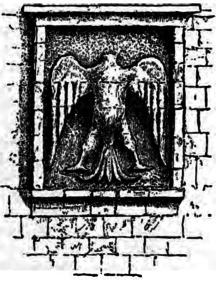
The Citadel was fortified by the Kurdish Ayyubid ruler Salah al-Din (Saladin) between 1176 and 1183 CE, to protect it from the Crusaders.[1] Only a few years after defeating the Fatimid Caliphate, Saladin set out to build a wall that would surround both Cairo and Fustat. Saladin is recorded as saying, "With a wall I will make the two [cities of Cairo and Fustat] into a unique whole, so that one army may defend them both; and I believe it is good to encircle them with a single wall from the bank of the Nile to the bank of the Nile." The Citadel would be the centerpiece of the wall. Built on a promontory beneath the Muqattam Hills, a setting that made it difficult to attack, the efficacy of the Citadel's location is further demonstrated by the fact that it remained the heart of Egyptian government until the 19th century.[3] The citadel stopped being the seat of government when Egypt's ruler, Khedive Ismail, moved to his newly built Abdin Palace in the Ismailiya neighborhood in the 1860s. While the Citadel was completed in 1183–1184, the wall Saladin had envisioned was still under construction in 1238, long after his death.
To supply water to the Citadel, Saladin built the 85-metre (280 ft) deep[4] Well of Joseph (so-called because Saladin's birth name, Yūsif, is the Arabic equivalent of Joseph), which can still be seen today. This well is also known as the Well of the Spiral because its entrance consisted of 300 stairs that wound around the inside of the well. Once water was raised from the well to the surface, it traveled to the Citadel on a series of aqueducts. During the reign of al-Nasir Muhammad, the Well of Joseph failed to produce enough water for the numerous animals and humans then living in the Citadel. To increase the volume of water, Nasir built a well system that consisted of a number of water wheels on the Nile, the water from which was then transported to the wall and subsequently to the Citadel, via the aqueducts Saladin had constructed.
The improvements to the Citadel's water supply were not Nasir's only additions to the Citadel, which was subject to a number of different additions during the Mamluk period. Nasir's most notable contribution was the Mosque of Nasir. In 1318 Nasir rebuilt the Ayyubid structure, turning it into a mosque in his name. The structure underwent further additions in 1335. Other contributions to the Citadel during Nasir's reign include the structure's southern enclosure (the northern enclosure was completed by Saladin) and the residential area, which included space for the harem and the courtyard. Prior to Nasir's work on the Citadel, the Baybars constructed the Hall of Justice and the "House of Gold."[3]
19th-century
The Citadel is sometimes referred to as Mohamed Ali Citadel (Arabic: قلعة محمد علي Qalaʿat Muḥammad ʿAlī), because it contains the Mosque of Muhammad Ali, which was built by Muhammad Ali Pasha between 1828 and 1848, perched on the summit of the citadel.[5]
This Ottoman mosque was built in memory of Tusun Pasha, Muhammad Ali's second son who died in 1816. However, it also represents Muhammad Ali's efforts to erase symbols of the Mamluk dynasty that he replaced. When Ottoman ruler Muhammad Ali Pasha took control from the Mamluks in 1805 he altered many of the additions to the Citadel that reflected Cairo's previous leaders. One obvious change that Muhammad Ali enacted pertained to the uses of the Citadel's northern and southern enclosures. During the Mamluk period the southern enclosure was the residential area, but Muhammad Ali claimed the northern enclosure as the royal residence when he took power. He then opened the southern enclosure to the public and effectively established his position as the new leader.[6]
The mosque is the other feature of the Citadel that reflects the reign of Muhammad Ali. This feature, with its large dome and overtly Ottoman influenced architecture, looms over the Citadel to this day. Recently destroyed Mamluk palaces within the Citadel provided space for the formidable mosque, which was the largest structure to be established in the early 19th century. Placing the mosque where the Mamluks had once reigned was an obvious effort to erase the memory of the older rulers and establish the importance of the new leader. The mosque also replaced the mosque of al-Nasir as the official state mosque.[5]
Mosques
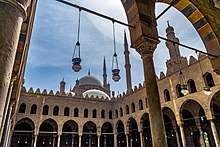
There are three main mosques at the Citadel:
The mosque was built between 1830 and 1848, although not completed until the reign of Said Pasha in 1857. The architect was Yusuf Bushnak from Istanbul and its model was the Sultan Ahmed Mosque in that city.[7][8] Muhammad Ali Pasha was buried in a tomb carved from Carrara marble, in the courtyard of the mosque. His body was transferred here from Hawsh al-Basha in 1857.
Built in 1318, during the early Bahri Mamluk period[9], as the royal mosque of the Citadel where the sultans of Cairo performed their Friday prayers, today this hypostyle mosque is still similar to how it looked in the 1300 though many repairs have been made. It is open to the public though infrequently visited by tourists. The parts of the building relying on plastered walls have been reinforced. There have also been attempts to restore the light-blue color of the ceiling.[10]
Built in 1528, it was first of the Citadel's Ottoman-style mosques. It was built on the ruins of an old mosque of Abu Mansur Qusta.
Museums
The Citadel also contains museums:
- Al-Gawhara Palace Museum
Also known as Bijou Palace, is a palace and museum commissioned by Muhammad Ali Pasha in 1814. The palace was designed and constructed by artisans contracted from a variety of countries, including Greeks, Turks, Bulgarians and Albanians.[11] Muhammad Ali's official divan or audience hall, where the pasha received guests, contains a 1000kg chandelier sent to him by Louis-Philippe I of France. The palace also contains the throne of Muhammad Ali Pasha that was a gift from the King of Italy.[11]
Inaugurated in 1983, it houses a collection of unique Royal Carriages attributed to different historical periods, from the reign of Khedive Ismail until the reign of King Farouk, in addition to other collection of unique antiques related to the carriages.
The official museum of the Egyptian Army. The museum was established in 1937 at the old building of the Egyptian Ministry of War in downtown Cairo. It was later moved to a temporary location in the Garden City district of Cairo. In November 1949 the museum was moved to the Haram Palace at the Cairo citadel. It has been renovated several times since, in 1982 and 1993.[12]
Gallery
.jpg) Cairo Citadel, in 2010
Cairo Citadel, in 2010 Postcard showing the Cairo Citadel and Muhammed Ali Mosque
Postcard showing the Cairo Citadel and Muhammed Ali Mosque- Cairo Citadel from different angle
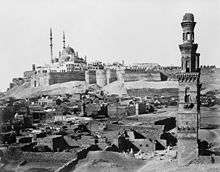 Cairo Citadel in the 19th century
Cairo Citadel in the 19th century On the Way between Old and New Cairo, Citadel Mosque of Mohammed Ali, and Tombs of the Mamelukes, by Louis Comfort Tiffany, c. 1872
On the Way between Old and New Cairo, Citadel Mosque of Mohammed Ali, and Tombs of the Mamelukes, by Louis Comfort Tiffany, c. 1872.jpg) An open-air market, 1907
An open-air market, 1907
References
- 1 2 Ades, Harry (2007). A Traveller's History of Egypt. Arris Publishing Ltd. p. 226. ISBN 1-905214-01-4.
- ↑ UNESCO, Decision Text, World Heritage Centre, retrieved 21 July 2017
- 1 2 Raymond, Andre (2001). Cairo. trans. by Willard Wood. Harvard University Press. pp. 85–132.
- ↑ Ripley, George; Dana, Charles A., eds. (1873). "Cairo". American Cyclopaedia. D. Appleton And Company.
- 1 2 "The Mosque of Muhammad Ali (history)". Archived from the original on 2006-02-07.
- ↑ Dunn, Jimmy (2006-04-07). "The Citadel in Cairo". Touregypt.net. Retrieved 2012-03-28.
- ↑ Blue Guide Egypt - Second Edition, 1988
- ↑ Glasssteelandstone.com - Mosque of Muhammad Ali
- ↑ Ades, Harry (2007). A Traveller's History of Egypt. Arris Publishing Ltd. p. 237. ISBN 1-905214-01-4.
- ↑ "Egypt: Citadel of Cairo." Egypt Travel, Tours, Vacations, Ancient Egypt from Tour Egypt. Web. 09 Mar. 2011. <http://www.touregypt.net/citadel.htm>.
- 1 2 Johnston, Shirley. Egyptian Palaces and Villas. New York: Abrams. ISBN 0-8109-5538-5. Photographs by Sherif Sonbol
- ↑ "Egypt Military Museum in the Citadel". Ask-aladdin. Retrieved 2 March 2013.
External links
| Wikimedia Commons has media related to Cairo Citadel. |
Coordinates: 30°01′46″N 31°15′41″E / 30.02944°N 31.26139°E
.jpg)
